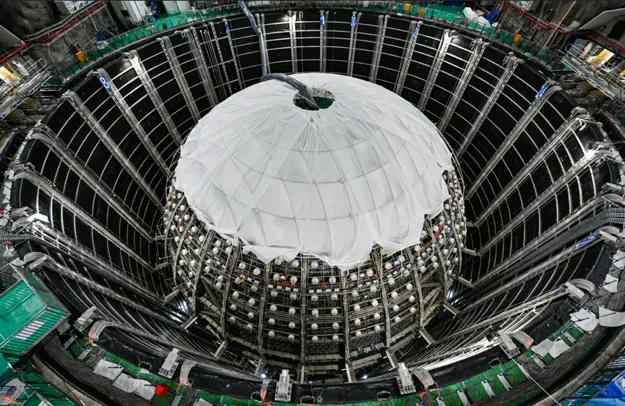Neutrinos have so far been the biggest puzzle for particle physicists. Their properties appear mysterious and point to previously not understood physics beyond the established standard model. Today, we know that neutrinos have a tiny mass, but their exact weight is just as unknown as the answer to which of the three known types of neutrino is the lightest and which is the heaviest. However, the so-called neutrino mass order is one of the most urgent questions in current neutrino research. To clarify this, construction work began in China in 2015 at the Jiangmen Underground Neutrino Observatory (JUNO), which is now operational.
The acrylic glass sphere is filled with 20,000 tons of detector liquid
The central detector consists of the largest acrylic glass sphere ever built. This has a diameter of 34.5 meters with an extremely thin wall thickness of 12 cm, which makes it particularly translucent. This sphere, which could easily accommodate a typical Bavarian church tower, is filled with 20,000 tons of a highly pure organic scintillation liquid. When elementary particles (such as neutrinos) interact with this liquid, weak blue flashes of light are created, registered by 43,000 photosensors. With its 20,000 tons of scintillator, JUNO is twenty times larger than previous such neutrino detectors. To shield against cosmic radiation, JUNO is located 700 meters underground in a basin filled with 35,000 tons of highly pure water. It curbs the natural radioactivity of the surrounding rock and actively suppresses it using 2200 additional photosensors.
JUNO is located equidistant to two nuclear powerplants
JUNO is at the same distance (53 km) from eight nuclear reactors in the Taishan and Yangjiang power plants, making measuring the neutrino mass order possible. The energies of the neutrinos emitted by the nuclear reactors are recorded with unprecedented precision by detecting the light generated when they interact with the scintillator. Around 45 such interactions are expected per day. Over time, this creates a detailed spectrum containing information about the neutrino mass order as a fine structure.
First steps into a new era of neutrino physics
"Thanks to the expected energy resolution of the detector and the high event rate, we are now able to see this fine structure for the first time," says Prof. Lothar Oberauer, long-time head of the JUNO group at the Technical University of Munich (TUM). "With JUNO, we will measure neutrino properties with uncertainties well below one percent and thus take the first steps into a new era of neutrino physics."
"In six years, we will be able to answer the question of the neutrino mass order. In addition, we will have determined many other properties of neutrinos with particularly high accuracy," adds Dr. Hans Steiger, principal investigator at the Collaborative Research Center 1258 and, since October 2024, the new head of the TUM JUNO team. "But we expect the first results in just a few weeks. Therefore, the next few months will be particularly exciting in neutrino physics."
The research program includes astronomy and geophysics
The JUNO research program also includes contributions to astronomy, such as the physics of dying giant stars (supernovae) and geology with neutrinos, which allow a novel deep insight into our planet’s interior.
The JUNO collaboration includes almost 700 scientists from 69 institutions in 16 nations. In Germany, in addition to the Technical University of Munich, the universities in Mainz, Aachen, Hamburg, and Tübingen, as well as the Helmholtz Society, are also participating in the experiment.
Contact:
Dr. Hans Steiger
Technical University of Munich
School of Natural Sciences, Physics Department
Collaborative Research Center 1258 (SFB1258) ‘Neutrinos and Dark Matter in Astro- and Particle Physics’
E-Mail: hans.steiger(at)tum.de

